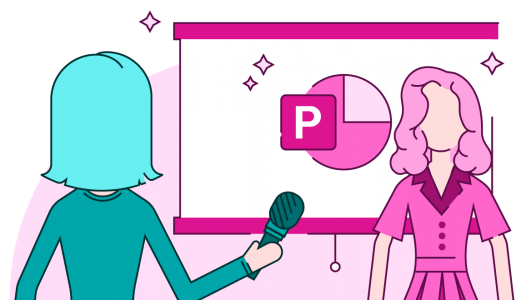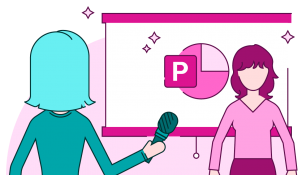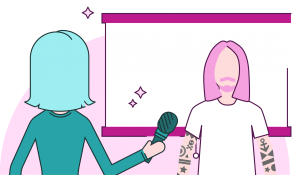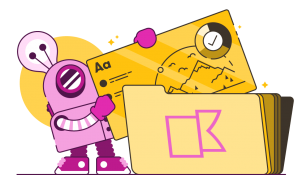Bianca Woods is the founder of the learning and development studio Clever Raptor, and Senior Manager of Programming for The eLearning Guild. She took a short reprieve from hopping between industry events and juggling design projects to talk to us. We covered a lot of ground! Read on for a journey through art, education, training, and presentations, by way of top tips for visual design beginners, and places to get the best visual inspiration (hint: it’s not just for weddings and recipes).
I know that you started in art education and I was wondering if you could tell me a bit about your journey through education and what you’re doing now.
The original plan was to be an art teacher. I did it for a year and really enjoyed it, but I was teaching in Florida. I’m originally from Toronto, Canada and wanted very much to move back home. So, I did but after jumping through all the recertification hoops I needed to, there just weren’t any available teaching jobs in Toronto.
So, I was working as an executive assistant – just trying to figure out my options – and a friend of a friend suggested looking at corporate training jobs. Specifically, he said, “instructional design.” I had no idea what that was – at all! They do not teach you about that when you’re training to be a teacher, that there are other places you can use your skills.
I ended up doing some grad school work, got another degree, and started doing corporate training here in Toronto.
It was a fascinating mix of doing things in a digital space – eLearning, videos, eBooks – and also designing for classroom – creating really engaging PowerPoint slides. I was working for a bank and their slides were basically, “Here’s 8 million bullet points on the corporate template!”
That sounds familiar!
It was interesting because in the corporate training field as a whole there aren’t a lot of people with a graphic design or visual design background in it. They can make really engaging classroom experiences but the support materials that go alongside them sometimes…aren’t so great.
A lot of what I specialised in when I moved into this new career was leveraging how you can use graphic design to help people learn. I wanted to help people be thoughtful about avoiding cognitive overload, enable them to create user experiences that were really easy to follow, and get them out of the mindset that this is just about making things pretty. If we get the visual design right, it makes it easier for people to understand the information we’re trying to convey to them, and they can do better on the job: that’s the goal.
Did that philosophy of visuals come from your teaching education?
When I was teaching art, I knew there was some part of it that was more than just aesthetics – although aesthetics is fine! Going back to grad school, Garr Reynolds’ Presentation Zen was required reading. And it was kind of this game changer: the idea that visuals had value for communicating information was always in my mind, but this was someone was reassuring me and saying, “yes, and here’s why.” It was a massive pivot point for me.
From what I’ve seen from working with our clients, lots of people know that the way we communicate visually is a problem, but they can’t pinpoint the why. It’s so important to understand the why in order to do something about it.
A lot of my work at conferences is about helping people in Learning and Development who don’t have a graphic design background. They find visual design kind of intimidating, and say things like, “I’m not artistic. I don’t think I can do this. And really, how does it help me anyway? It’s just about making things pretty.” What I try to do is assure them that – one – yes you can do this I promise, and – two – here’s why it matters, here’s how it helps you accomplish what you’re trying to accomplish.
People have good gut instincts about if something is kind of clunky looking. But if they don’t have someone to walk them through the basics of visual design, they can get stuck on how exactly to fix it.
There are a lot of fields where we shove software like PowerPoint, or Keynote, or eLearning design tools at people who don’t know anything about visual design and say, “Hey, do this! Here’s your tool!” So, they use the templates that come with it. And with PowerPoint the template you get has a header and bullets, so it’s no wonder that what we see all the time is…a header and bullets.
It’s all about replacing the defaults that people are given with some new, visual fundamentals. What are the core philosophies or approaches that you start with when teaching people?
I try to start with things that don’t require understanding a lot about visual design, actually. One of the biggest things I talk to people about as they’re getting started is to look for opportunities to trim back information. Even if you couldn’t do visual design to save your life at that moment, you can always look at whatever you have and think, “What can I get rid of without losing any meaning?”
It’s a good baby step for people because, like I said, this whole visual design/art thing is very intimidating for some people and they kind of emotionally shut down. But saying something as simple as, “What can you remove?” makes it a lot more comfortable. They have some experience with editing, and this is just editing both text and visuals. It’s a good start and quite empowering. They see how much of a difference it can make and begin to think, “Maybe I can pull this off!”
That makes sense, it’s definitely where I would start! That idea of people being intimidated is really familiar, and not only from training people, but also from handling presentation clients. Sometimes they’re not only intimidated, they don’t see the point. They say, “It’s just PowerPoint,” or “It’s just eLearning. Why does it need to be visual?” What’s your role in educating clients and helping them to buy into that approach?
It does depend on the client.
When I’m working with instructional designers, I talk a lot about learning theory and how visuals can help, particularly from the aspect of cognitive load. A person’s brain can only take in a certain amount of information at a time. So, if you’re loading the brain with superfluous things, you’re using up that processing space and preventing things from making it to long-term memory. This clicks well with someone who has a learning background. They may understand cognitive load from another perspective but not have thought about it with visuals.
Now, if we’re working with clients who aren’t learning people that is not the place I go. That’s not an explanation that has meaning to them. Sometimes instead I’ll talk about the power of clear communication, the power of storytelling.
The nice thing about the popularization of things like TED talks is that people know what a simpler slide deck can look like and how different it is from some of the horrifyingly bad presentations they’ve seen.
I think if I were trying to do this 10 years ago it would be brutal because there was not as much of a reference point in popular culture.
Getting that narrative right as well as the graphic design, and marrying the two, is such a big part of what we do at BrightCarbon. I think a lot of presentation designers and instructional designers are adding compelling storytelling as a tool in their box.
Stories are amazing tools. Sometimes I’ll have clients who are very focused on the slide deck, and I have to refocus them: “No, we’ve got to get your story right first. Then we’re going to build a deck that’s going to help you tell that story and tell it in a way that’s right for you.”
There isn’t one way to make a deck that’s perfect for everyone: it’s about finding that nice mesh of what fits the story, what’s compelling and what helps that particular speaker and the way that they speak.
At the bank where I started out doing corporate training, sometimes people would have interesting information to share, but they wouldn’t have a compelling way to tell it. Or they’d tell it in a way that only made sense to other people in their department. Or it’s just, “Here’s a data dump!” And, yes, technically everything they shared is accurate, but they left out why the audience should care.
We need to shift people’s mindsets to start with the why – and I’m quoting Simon Sinek here but he’s not wrong on that! Figure out the compelling thing, not for the person presenting at the front of the room, the compelling thing for the audience. If you can nail that, then everything else just kind of clicks into place.
And that audience could be people sitting in a presentation, or learners engaging with some eLearning. It’s interesting, there’s such a growing focus in the corporate world on user experience design. It’s being talked about a lot. But instructional designers are user experience designers, presentation designers are user experience designers: it’s always been about that end point!
Absolutely. It’s been interesting seeing user experience design come so far in the last few years. In some ways it’s stuff I’ve been doing as a teacher and as an instructional designer for a long time. It’s very reassuring to see other people go, “This matters!” Because it does. These are skills a lot of people have already been using but they’re now in a more concrete package, being used in a more methodical, purposeful way rather than accidentally or vaguely.
Doing things deliberately is a huge step. We often get asked, “What is good eLearning?” Clearly, considering the user – or the learner – is key, but there’s more to it then that. How would you answer that question?
What makes good eLearning is the same as what makes good visual design. It’s going to vary wildly depending on your topic, your context, and your audience. So, the thing that I always warn people when teaching them about visual design is that there is not one magic formula. There’s no “one ring to rule them all” approach to visual design, and it’s the same for eLearning.
The problem is when people have one tool to make eLearning with, and think if they use it to make everything, it will all be magical and solve everything! And it doesn’t! Then they’re disappointed, but they don’t know why. And it’s because it wasn’t a reasonable expectation.
Obviously, you can be constrained by the tools you have to an extent, but we see how much you can make using just PowerPoint. So, it’s really about understanding the theory and what you’re trying to do, and not being limited just by the tools you have.
Yeah, or not being married to one tool. I’ve seen people in this field, executives, go in and go, “We’re going to make 10 new eLearning courses with Storyline!” or what have you. And you want to stop them and suggest you talk about what’s the right fit for the situation before committing to this. Don’t lead with the tool.
There are some core things that go into a good presentation or learning experience, regardless. Thinking of your audience, understanding what’s best for them, and being respectful of their time -particularly if you’re working with people on the job.
Sometimes you see people default to a very long solution. Maybe learners will need to do 8 hours of in-class or digital training. But is that right? If someone actually needs a job aid beside their computer reminding them how to do a process, then taking up 8 hours of their time isn’t respectful, and it’s not good for the business.
When subject matter experts at the bank wanted to do a text dump, I used to work out the time to complete it – let’s say 30 minutes. If each person doing the training is paid $30 per hour, that’s $15 per person to have them read through this content. If the training goes to everyone at the bank, that’s 50,000 employees! So, I’d calculate how much it would cost them to do 30 minutes of training when 15 minutes would have done. When you start saying that extra 15 minutes is going to cost $375,000 of time to the company, they start going, “Ohhh!”
Any time you have someone in training, it costs money to have them there, even if it’s just time they could have spent on something else.
Plus, people know when they’re getting a text dump, when they’re getting information they don’t need. They don’t feel respected by that experience and it makes them tune out from what you’re giving them. They are probably going to learn way less than if you’d just given them exactly what they needed.
Definitely. And the consensus in our industry seems to be that the best place to start understanding what exactly it is that people need is by talking to learners, to people, directly and finding out about their situation. How do you handle this with your projects?
It depends on the project. Recently, I was subcontracting for someone else, so I was one step removed from the client. In situations like that, you can do your best to get someone to tell you about the audience, but you can’t actually speak to them. It’s hard!
As instructional designers we know the difference that can make in making the solution right. But we’re in situations where the expectation has been, “We tell you what we need, and you make the thing,” without a realisation that – one – maybe the thing you’re requesting isn’t the best fit for the audience and – two – direct contact between the person who’s making the thing and the people it’s being made for makes a difference. We’re starting to make some progress with that. I think it’s important and I’ve really valued the times I’ve been able to do it.
The nice thing about user experience design becoming something that more people know about is that this contact is such a core component. You might be having a conversation with someone who isn’t a learning person, but they’ve probably heard about design thinking at this point, or user experience design. So, now people understand what you’re talking about in a way they might not have before.
It’s great that it’s becoming more familiar, and people are seeing that it’s about more than web development.
Yeah, it can be a fun thing to steal from other industries!
Definitely! And looking outside of our industry for inspiration can be a really useful way to avoid getting stuck in that box where you’re using the same tool for everything, the same structure for every course. Where do you go to get that outside perspective?
I’m all about everyday inspiration. Having a fine art background means I do a lot of reading books and following Instagram accounts about illustration. That fuels how I think about visualising content.
I am weirdly obsessed with warning signs! I’ve been taking pictures of funny caution signs for many, many years. I started an Instagram account recently just so I could collect them all in one place. Sometimes they’re hilariously weird. It’s so interesting to think about how you communicate with zero words at all. Sometimes the visualisations in those is so over the top, partly because they want to grab your attention, and partly because if you don’t read English and the sign’s in English, I still want you to not accidentally walk on the train tracks! I love that.
I’m very into signage and wayfinding right now. I find that giving directions in physical space inspires me a lot for how to give directions and indication in digital space. Train maps, signs at airports…I’ll take pictures of things that are really fantastic examples to remember later. And I’ll take pictures of things that are confusing and break down why they don’t work and how I’d do them better.
I love video games for inspiration. Video game tutorials are some of the best inspiration for how to teach. A lot of the successful tutorials are built into the experience and you don’t even realise you’re learning something new. That’s sneaky, and I like it!
One of the secrets is: take pictures! Put together Pinterest boards! Don’t just take it in in the moment, collect it for later. Sometimes you will be mentally stumped. If you have a place to go -whether it’s a folder on your desktop or a Pinterest board – if you have collected this stuff over months and years, then you have a space to go to refresh your brain. I have Pinterest boards about all sorts of design related things that I use as mental fuel.
That’s super good advice: I’m going to start doing that!
Do it! Everyone’s like, “Pinterest is for weddings and recipes,” and I’m like, “Yes, and?!” If you’re a designer it is the absolute best place for storing things that inspire you or things that make you think, “That’s the worst thing ever and I want to remember how bad it is.” I have this whole board on terrifyingly bad infographics as just a, “Don’t ever do that Bianca!”
Seeing what doesn’t work is definitely a good way to stay inspired, and it can be some light relief as well!
We designers tend to be those people whose friends have to put up with us throwing our hands in the air, like, “This is terrible!”
Papyrus!
Oh, my goodness, yes! I get mad at really bad instructions all the time. Or when the design is most of the way there and there’s one glaring, awful thing…you were so close!
It’s definitely nice coming into the BrightCarbon office and be able to share in those design frustrations with others. Having a community of people to share that with is helpful.
It’s amazing. One of the things I’ve liked most about Twitter is being able to connect to different communities. There’s the learning design community, and the presentation design community. There are things where – unless they’re also a part of that field – people don’t get why they bother you or what’s hard about them or what’s inspiring about them.
Finding your people does a lot to help you keep going and feel inspired. Or even just understood.
If other learning designers or presentation designers are looking to connect with other people, where would you recommend, they go?
For the last 3+ years I’ve been working for The eLearning Guild. It’s a professional organisation, one that I’ve been a member of since I was in grad school. So, it’s not just a company I work for. I was reading their articles when I was in school, I was going to their conferences when I was a just regular practitioner, then I was speaking at their in-person and online events and eventually started working for them.
The community aspect of that has been immensely helpful for my career: the connections I’ve made through meeting people at conferences and getting involved with online conversations with the people I’ve met there. We do a Twitter chat every week called #GuildChat – that is a great way to meet new people, especially if you can’t go to a conference right away. And we do online conferences.
Professional organisations like that are amazing for making new connections. Within presentation design there’s the Presentation Guild, which is run by volunteers, they’re fantastic, brilliant people!
The people in both these communities are so giving. It’s not about seeing each other as competition, it’s about seeing each other as collaborators. People give advice, share templates, share design ideas, they’ll help you talk through something if you’re stuck, just out of the goodness of their hearts.
I think that’s why you get into teaching, or education, or presentation design: you want to help others. If you are making a presentation for someone else, it’s not about your success! It’s about someone else’s success. So of course the kind of people drawn to that work are the people who would bend over backwards to help others in the field.
I just went to Click, Richard talked at that as well. That event was delightful in terms of being in a shared space with other people who are super excited about presentation design. I’ve met other people who are excited about presentations, but never been in a whole conference filled with them! So, that was amazing!
I’m about to go to a conference here in Canada called the Canadian eLearning Conference. It’s a smaller conference than some of the Guild ones, but still features wonderful people.
I love the Guild conferences, but I think it’s also nice to find events in your back yard. We have an Articulate Storyline user meetup in Toronto and I know there’s others.
We have one here in Manchester!
They’re great ways to find people dealing with the same challenges you’re dealing with and make those connections and feel like you’re not alone. Especially if you’re working for yourself or are the one person in your organisation doing eLearning or presentations.
I work at home, and what I miss about working an office is walking over to someone’s desk and asking, “What are you working on?” Or just grabbing a coffee and taking a break to talk through a problem with someone. The substitute I have found for this is Twitter, to a lesser extent LinkedIn and Facebook, and then going to events – because you can have those same kinds of interactions.
We hope to run into Bianca at the next event we are both attending! To find out where that might be, follow Bianca on Twitter. And be sure to check out the awesome resources she has available on her website, too. Thanks so much to Bianca Woods for spending the time sharing her insights with us, and the wider community. Til next time!
Leave a comment





Best methods you have shared here about education